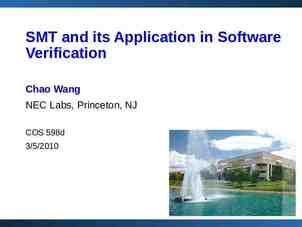November 2003 doc.: IEEE 802.11-03/950r1 The Need for Managed
12 Slides92.00 KB

November 2003 doc.: IEEE 802.11-03/950r1 The Need for Managed IEEE 802.11 Devices Harry Worstell AT&T Research [email protected] Martin Lefkowitz Trapeze Networks [email protected] Sudheer Matta Trapeze Networks [email protected] Kazuyuki Sakoda Sony [email protected] Zhun Zhong Tim Olson J Kim Philips Cisco AT&T Research [email protected] [email protected] [email protected] Submission Slide 1 Harry Worste

November 2003 doc.: IEEE 802.11-03/950r1 Outline of presentation 802.11: Indoor Wireless LAN Migration 802.11: WLAN History Study Group Purpose Statement Expected topics for remotely managed dot 11 devices How will the dot 11 devices get managed Questions and Discussion Straw Poll Submission Slide 2 Harry Worste

November 2003 doc.: IEEE 802.11-03/950r1 802.11: WLAN History 1940: Spread spectrum technology first used by the military 1980: Limited applications using narrowband technology 1989: FCC assigns frequency for commercial use. ISM bands authorized (900 MHz, 2.4 GHz, 5 GHz) 1990: 900 MHz products begin shipping – IEEE begins work on industry standard 1994: 2.4 GHz products begin shipping 1997: IEEE 802.11 standard approved. – 2.4 GHz products begin dominating the scene 1998: FCC authorizes the UNII Band 1999: IEEE 802.11a&b standard ratified. – WECA formed for interoperability testing – Wide Band Frequency Hopping NPRM Released by FCC – “Enhanced MAC - QoS and Security” Task Group chartered 2001 QoS/Security enhancements Task Groups begin 2003 FCC expands the UNII band by 200MHz (12 channels) Submission Slide 3 Harry Worste

November 2003 doc.: IEEE 802.11-03/950r1 802.11: WLAN History (cont.) Early 1980’s- began selling vertical market narrowband solutions geared to the retail and manufacturing industries. 1985- FCC authorizes the ISM bands for WLAN, then assigns a frequency for commercial use in 1990. 1990, NCR (now Lucent/Avaya) and others penetrate the horizontal markets with 900MHz products, but many factors prevented market penetration. – Cost (low quantities) – Speed (1-2 Mbps) – PC Integration: Awkward antenna’s and products – Market acceptance of the technology 2000- LANs with QoS support become an industry focus due to growth of multimedia, streaming, VoIP, and home networking of broadband cable/DSL services 2003 – Extension of wired managed services to wired and wireless managed service in enterprise (large and medium scale), hot spot, campus markets grow due to market penetration of wireless devices, high cost of IT personnel and poor economy. Submission Slide 4 Harry Worste

November 2003 doc.: IEEE 802.11-03/950r1 802.11: Indoor Wireless LAN Migration First Generation Wireless LANs A A Peer/Peer and Client/Server Small User Population Isolated "Cells" and User Groups Non-Contiguous Coverage Indoor Operation Limited Mobility Mostly Asynchronous Traffic Slower than Ethernet IEEE 802.11 Fourth-Generation of Wireless Communications Larger User Population Managed Services Full Roaming/Handoff Capability Contiguous Coverage in Dense Areas Wider Area Coverage for Community LANs Mobility (Follow-Me Service) Mix of Async and Isochronous Traffic Higher System Utilization Enhanced Security A C Second-Generation Wireless LANs B InterNet/IntraNet Ethernet-Compatible Speeds Multiple RF Bands to operate A Third-Generation Wireless Communications TDMA EDGE Wideband CDMA Submission Merge of 3G and 4G services (WLAN & WAN) Slide 5 Harry Worste

November 2003 doc.: IEEE 802.11-03/950r1 802.11: Indoor Wireless LAN Migration First Generation Wireless LANs A A Peer/Peer and Client/Server Small User Population Isolated "Cells" and User Groups Non-Contiguous Coverage Indoor Operation Limited Mobility Mostly Asynchronous Traffic Slower than Ethernet IEEE 802.11 Fourth-Generation of Wireless Communications Larger User Population Managed Services Full Roaming/Handoff Capability Contiguous Coverage in Dense Areas Wider Area Coverage for Community LANs Mobility (Follow-Me Service) Mix of Async and Isochronous Traffic Higher System Utilization Enhanced Security A C Second-Generation Wireless LANs B InterNet/IntraNet Ethernet-Compatible Speeds Multiple RF Bands to operate A Third-Generation Wireless Communications TDMA EDGE Wideband CDMA Submission Merge of 3G and 4G services (WLAN & WAN) Slide 6 Harry Worste

November 2003 doc.: IEEE 802.11-03/950r1 Study Group Purpose Statement The proposed Study Group will evaluate the need to provide mechanisms in 802.11 devices that enhance management capabilities and extend management of the wired networks to the wireless equipment attached to those networks. These mechanism enable the types of services that are extremely desirable for entities such as managed service providers, company IT personnel, hot spot providers, applications developers, etc. Once evaluated, it is expected that a PAR and a 5 Criteria document will be written and submitted to the IEEE 802.11 Working Group so that a Task Group can be formed. This is a logical extension to the work now underway in Task Group “k”. Submission Slide 7 Harry Worste

November 2003 doc.: IEEE 802.11-03/950r1 Process of Managed 802.11 devices in the Standards (Small steps to make good progress) Inter-Access Port Protocol Inter-Communications between APs (Now a Standard) Ability to obtain MAC and PHY measurements by Upper Layers (Now a Task Group) Radio Resource Measurements Enable external entities to manage Devices (APs and Clients) (Proposed Next Logical Step) Remote Managed Device Submission Slide 8 Harry Worste

November 2003 doc.: IEEE 802.11-03/950r1 Expected topics for remotely managed dot 11 devices Channel (frequency – APs & clients) Reset the Devices Remotely Antenna Selection Load Balancing Access to Client Power Control Rogue Handling Service Handling Enable mechanisms already in dot 11 to outside entities (TGh) Client Roaming Dynamic Adaptation of clients/AP Enable Interference Mitigation All of the above with some way to do security Submission Slide 9 Harry Worste

November 2003 doc.: IEEE 802.11-03/950r1 How will the dot 11 devices get managed MIB Application (OID’s) Over the air to client devices (by Management Action Frames) Others? Submission Slide 10 Harry Worste

November 2003 doc.: IEEE 802.11-03/950r1 Questions and Discussion Submission Slide 11 Harry Worste

November 2003 doc.: IEEE 802.11-03/950r1 Straw Poll Would you support forming a study group to evaluate the need to enable external network management entities extend the managed services of the wired networks through to the wireless devices attached to those networks, which is a logical extension of the measurement work now underway in TGk? Yes Submission No Abstain Slide 12 Harry Worste






